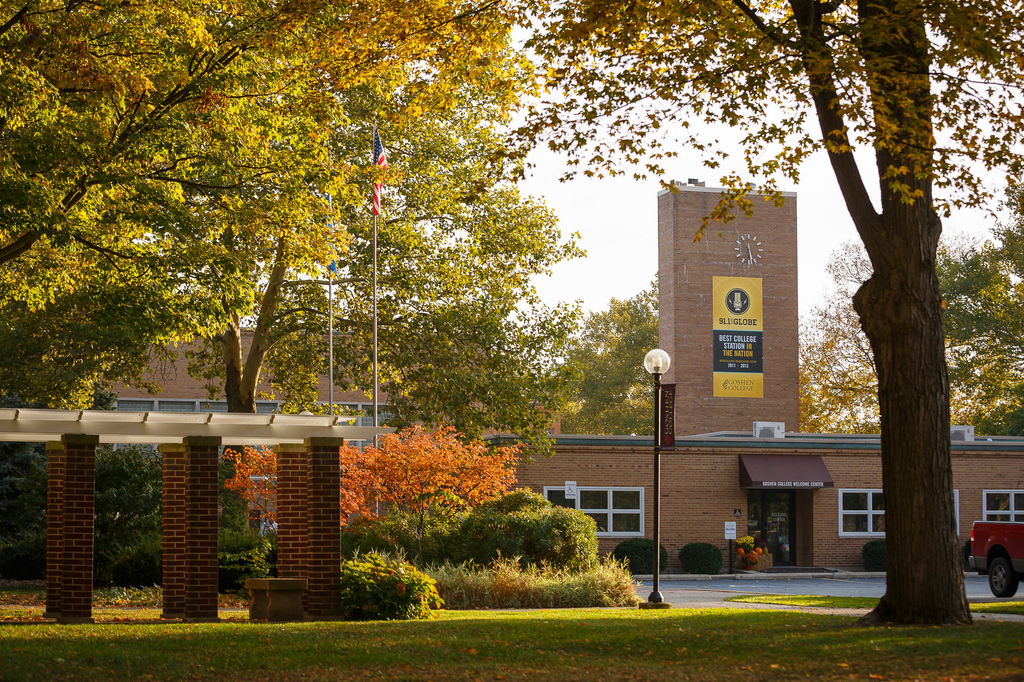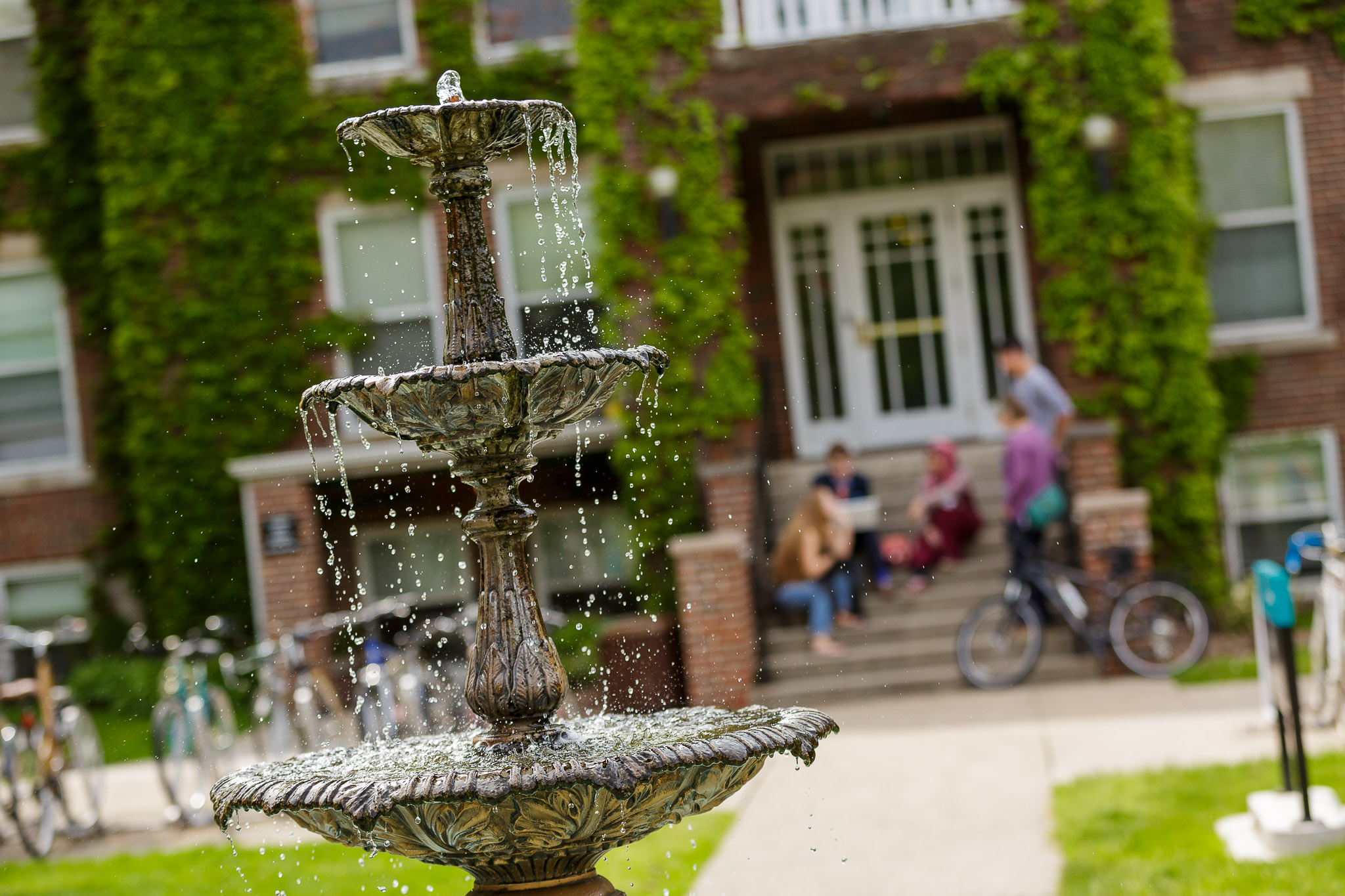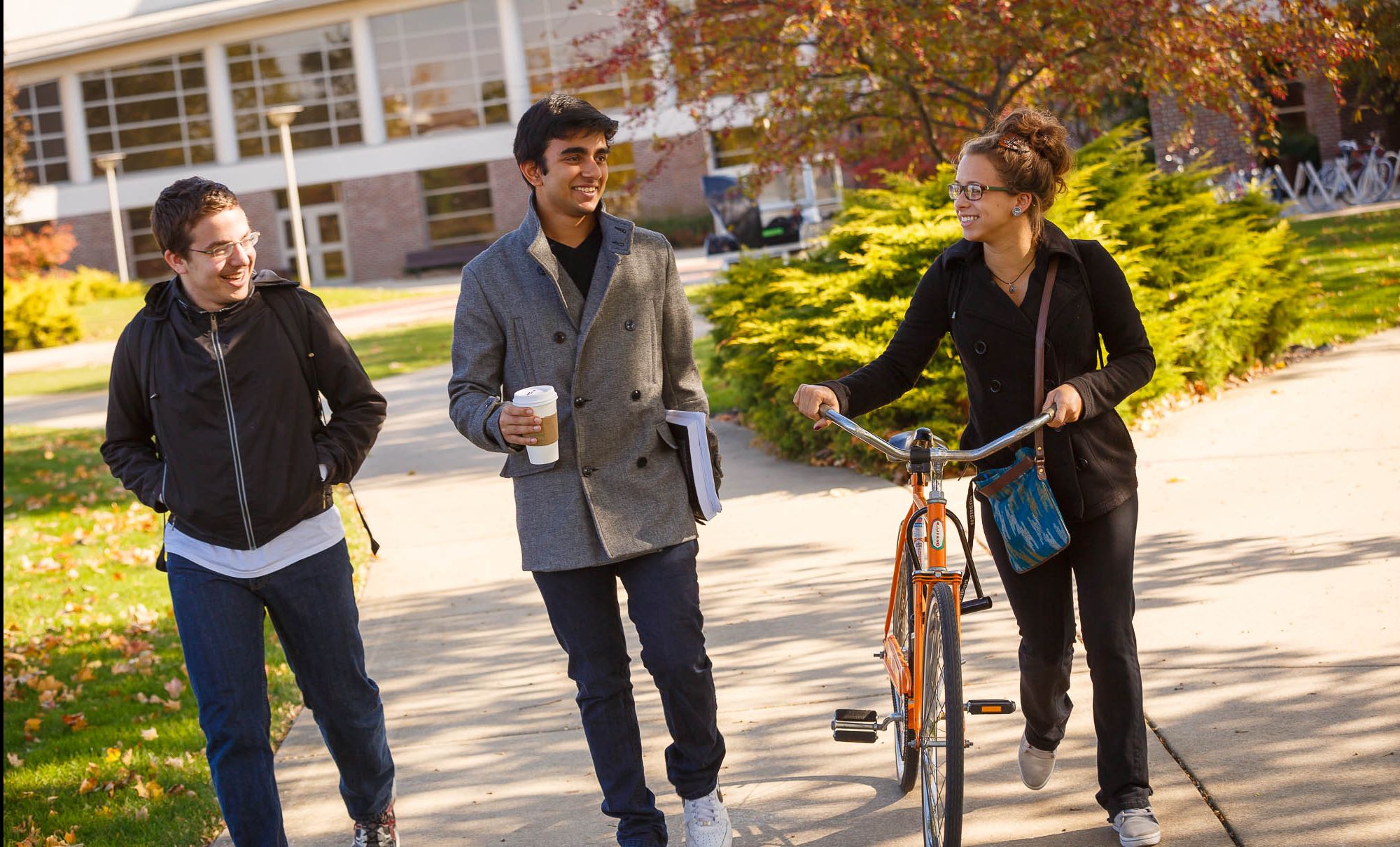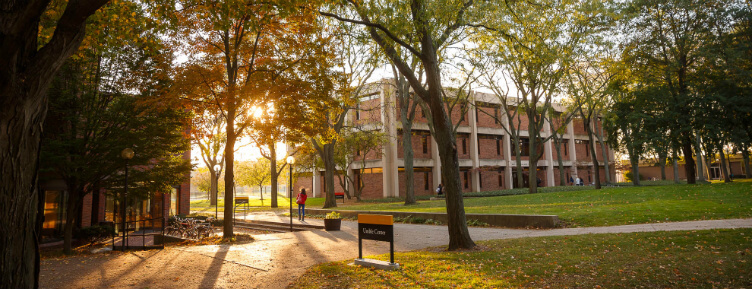President’s Speech: “Rifted Rocks”
Opening convocation speech, as prepared for delivery by President Rebecca Stoltzfus, on Wednesday, Sept. 1, 2021.
Good morning!
We acknowledge that we gather as Goshen College on the traditional land of the Potawatomi and Miami Peoples past and present, and honor with gratitude the land itself and the people who have been its stewards throughout the generations. This calls us to commit to continuing to learn how to be better stewards of the land we inhabit as well.
Welcome to fall 2021 at Goshen College! It is fantastic to be here, and I am excited for what this year will bring. If I haven’t met you yet, I can’t wait to learn to know you.
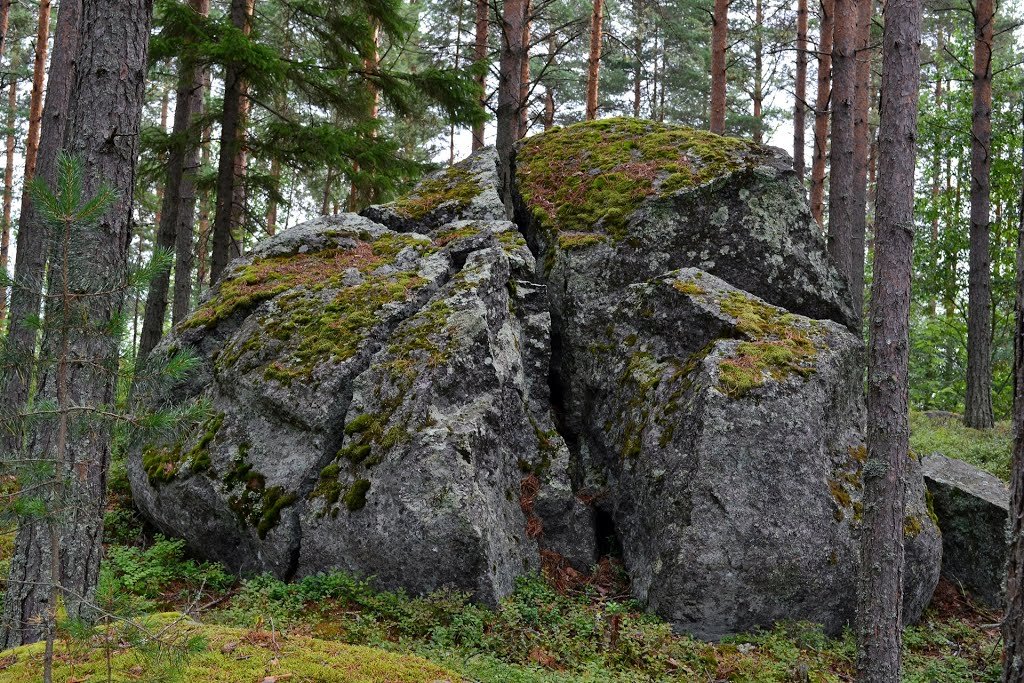
I’d like to introduce you this morning to this rifted rock. This rock is in a forest in Finland. It’s probably about 2 million years old, and came to the surface of the earth about 13,000 years ago.
Imagine if you were walking in this forest and a storm whipped up. Cold rain begins to fall, and the wind blows it slant and hard across your face. The sky becomes dark.
And then you encounter this boulder. What would you do?
I imagine you would pull your hood up over your head, and snuggle your backside into the open part, the gap, the cleft, the rift of the rock, feeling its firm protection from the wind and rain on three sides. Feeling its solid shelter at your back as you lean into it, finding a sanctuary in the midst of the storm unfolding around you.
Meet the rifted rock.
Goshen College has long embraced a set of core values that guide our learning and our campus life together. Each year, I open the fall convocation series by speaking about one of those core values. This year’s core value is compassionate peacemaking.
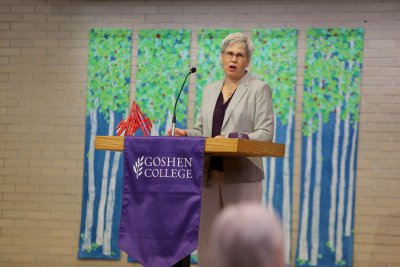
Hmmm. Compassionate peacemaking as a core value of college?
When I ask what brings you to Goshen College, I’m not sure that many of you would answer: because I want peace.
And yet, I expect that for every one of us — whether you are a student or employee — if we peel back the layers of what we are really striving for, peace is at the core of what we want in life.
For Christians, our English language word peace draws from the Hebrew word, ‘shalom,’ which, like the Arabic salaam, means not only peace but justice, good health, safety, well-being, prosperity, equity, security, good fortune and friendliness.
I want that! To be human is to want that! We all want that.
And even though on this earth, we may never have peace/shalom/salaam fully or indefinitely, we taste it, we experience it in moments.
I invite each of you — right now — to remember a moment when you felt deeply at peace. Maybe it was recent or long ago. When you felt deeply at peace.
Take your time.
What image comes to your mind?
Where were you?
How old were you?
Was anyone with you?
Most importantly: How did it feel? How does peace feel?
It is both scientifically true and spiritually true that that feeling of deep peace in the cells of your body shapes you — your metabolism, the neurochemicals in your brain, and the ways in which your genetic material replicates. The experience of peace in the cells of our body arises from shalom, but perhaps more importantly it creates shalom: it makes us healthy, when we feel at peace, we are more able to prosper, learning becomes easier, we do better on tests, we are friendlier.
Peace is primarily not a political idea, or a military goal, or a theological position; it is an experience.
It is an experience that can build a foundation for life.

1950’s film star Marilyn Monroe told a friendly reporter:
Really, I am trying to find myself, and the best way for me to do that is to try to prove to myself that I am an actress. And that is what I hope to do. My work is important to me. It’s the only ground I’ve ever had to stand on. To put it bluntly, I seem to have a whole superstructure with no foundation. But now I’m working on the foundation.”
Part of your Goshen College experience is about building your superstructure — your resume, your skills, your career. But Goshen will also help you work on the foundation. And finding peace is an essential part of a firm foundation.
It is natural that “peacemaking” is one of the core values of Goshen College, since this college is part of a five-hundred-year-old peace church heritage, the Anabaptist Mennonite tradition. Our core value of compassionate peacemaking arises from our commitment to be “Christ-centered” and rooted in the way of Jesus. Jesus said in his most famous sermon: “blessed are the peacemakers, for they shall be called children of God” (Matt. 5:9).
The peacemaking roots of Goshen College run deep. Roots of inner peacemaking and outward peacemaking that are connected within us and between us.
I don’t say this lightly. We head into this academic year navigating a pandemic, and systemic oppression, and the climate crisis, and democracies in peril, and our jobs and school and caregiving and life in general, and I’m sure you can add more of your own personal sauce to that.
And so, I want you — I want me — to know that rifted rocks exist in our landscape. Big old ancient foundations for peace that have our back if we look for them and allow them to support us.
This year, I want us to find those rifted rocks so that we can experience peace and offer peace.

Imagine yourself with your back against this rocky Irish coastline, as I read you a few lines I love from the Irish-American poet, David Whyte:
Feel the way the cliff at your back gives shelter to your outward view
and then bring in from those horizons
all discordant elements that seek a home.
Be taught now, among the trees and rocks,
how the discarded is woven into shelter,
learn the way things hidden and unspoken slowly proclaim their voice in the world.
Find that far inward symmetry to all outward appearances,
apprentice yourself to yourself,
begin to welcome back all you sent away,
be a new annunciation,
make yourself a door through which to be hospitable,
even to the stranger in you.
That is what I wish for you, for each of us, this year.
And to those of us who are so compelled the urgency of all the issues we face, who are drawn into the good and idealistic whirlwind of action for your causes, I give you these words of the catholic writer and social activist, Thomas Merton:
“To allow oneself to be carried away by a multitude of conflicting concerns, to surrender to too many demands, to commit oneself to too many projects, to want to help everyone in everything, is to succumb to violence. The frenzy of our activism neutralizes our work for peace. It destroys our own inner capacity for peace. It destroys the fruitfulness of our own work, because it kills the root of inner wisdom which makes work fruitful.” — Thomas Merton
I want you to know: You have an inner capacity for peace. Pay attention: The root of inner wisdom is real, it is called by many names — Inner Light, our conscience, Holy Spirit, to name a few — and it is alive within you. It is the way you were made. It is part of your operating system. I urge you to learn its language.
Inner peace can sound mysterious and difficult, and sometimes it is. But sometimes it is simple. It is about rest and sleep, and play and love, and good food and real conversations and gentleness.
As we find our own sanctuaries, we become rifted rocks for others. Shelters that others can lean on. We become firm foundations who embody compassion, non-violent ways of speaking, deliberation, and postures of openness. We find the courage and creativity to seek inclusive community and transformative justice in all that we do.
I want to tell you two stories about peacemaking at Goshen College.
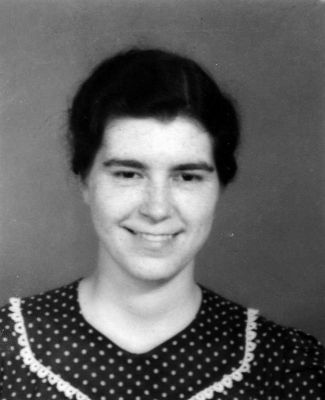
Lois Mary Gunden Clemens graduated from GC in 1936, and when she was 27, she moved to France to serve in an orphanage when Nazi Germany occupied France in World War II. The children in the orphanage were mostly Spanish children, fleeing the Spanish own civil war. But Jewish children began to come, refugees from the Nazis. Lois had to decide whether she would disobey the law and harbor refugee Jewish children hidden among the other children. Nazi soldiers repeatedly came to the door unannounced looking for any Jewish children to deport to the concentration camps. If she disobeyed them and got caught hiding Jewish children, all the other children would suffer. Lois chose to hide the Jewish children and to deceive the Nazi soldiers.
Her diaries tell of her anguish as she navigated the tension between her inner wisdom, the law of the land, and the duty of protecting all those in the orphanage, including herself. But she also found her rifted rock:
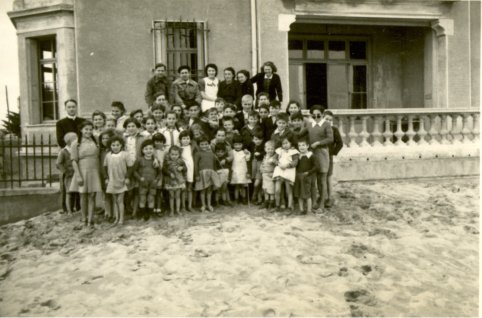
Lois wrote home in 1942:
… my year’s experience in relief work over here has taught me more than ever that one has to live only a day at a time, and that God’s faithfulness towards those who put their trust in Him can be counted upon for the experiences of each day as it comes bringing its particular problems. I know that without the assurance of God’s abiding presence and God’s sustaining help, I would feel lost in an impossible tangle of circumstances. …
This was Lois’ last letter home. On Jan. 27, 1943, Lois was taken as a prisoner of war and spent a year in the hands of the German government. Eventually negotiations led to her release and arrival in New York City on March 15, 1944.
From New York, Lois returned to Goshen and began teaching French at Goshen College that fall.
In 2012, after her death, Lois Gunden Clemens, became one of only two Americans ever to receive Israel’s Yad Vashem Holocaust Memorial “Righteous Among the Nations” award for her quiet, but daring acts of compassionate peacemaking.

Incidentally, Lois’s family was full of basketball players, and she was a sports fan who asked about the GC basketball team in her letters home. Lois was a sister to Ruth Gunden, our first director of women’s athletics. Our gymnasium is named after Ruth Gunden.
The second story is about a “rifted rock” symbol on our campus.
Forty years ago, a young instructor in our art department, John Mishler, collaborated with Goshen students to create the iconic Broken Shield sculpture that is in the center of our campus. Here it is in miniature form.
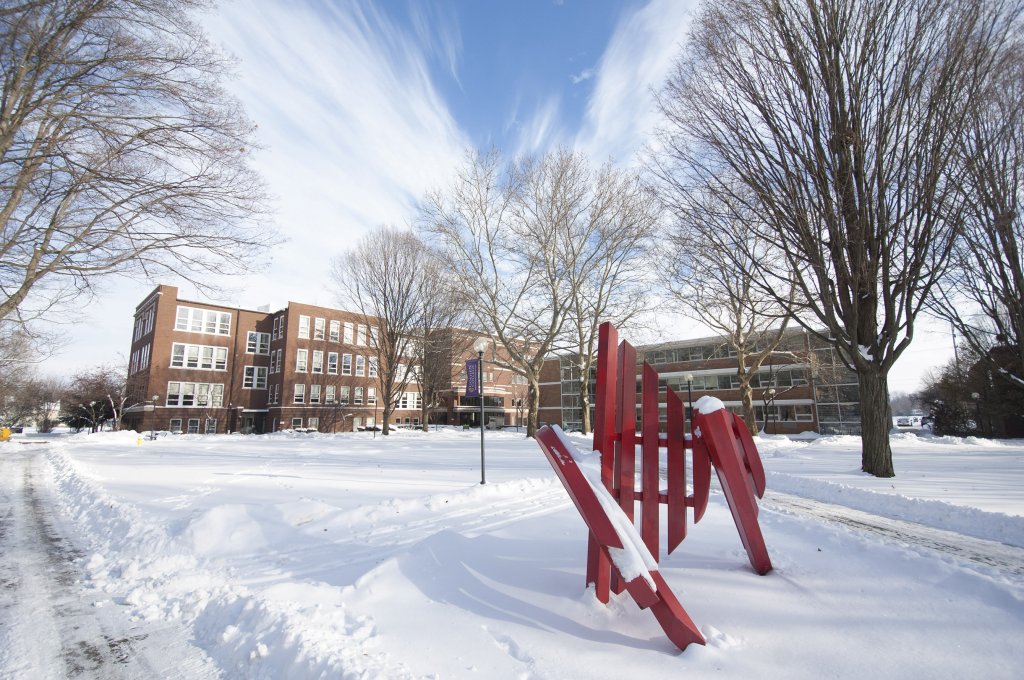
John Mishler is now a nationally celebrated sculptor known for his outdoor public art pieces with works in many spaces inside and outside the U.S. He continues to create here in Goshen and to teach here at GC, including his popular sculpture course in May term.
But in 1981, “Broken Shield” was John’s first public sculpture. His inspiration was the passage from Isaiah 2, which anticipates an age of peace when nations will “beat their swords into plowshares.” The shapes in the sculpture are suggestive of instruments used to work the earth. Both idea and form are representative of a peaceful way of life, living in harmony with the land.
John wrote to me that his hope was that “Broken Shield” would become a peace symbol and part of the college’s identity. The bold red-orange color, and the movement in the work reflects the energy necessary to keep such a symbol alive.
And so it has. Here is a photo published in The Record, of students using the Broken Shield sculpture as a site of vigil to protest the start of the First Gulf War, in 1991, 30 years ago.
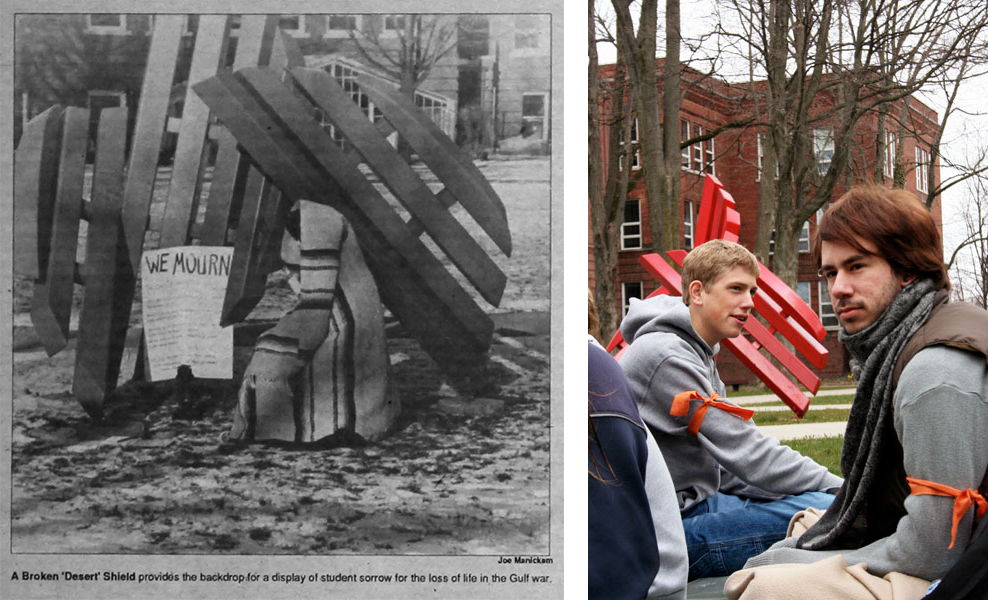
And in 2009, a student-led crowd of nearly 100 people gathered next to the broken shield to express their objection to our policy at that time against employing openly L.G.B.T.Q. faculty and staff. That policy was replaced by a new non-discrimation policy in 2015 — a change that we now celebrate.
Sometimes making peace means making what civil rights activist and senator John Lewis called “Good Trouble.”
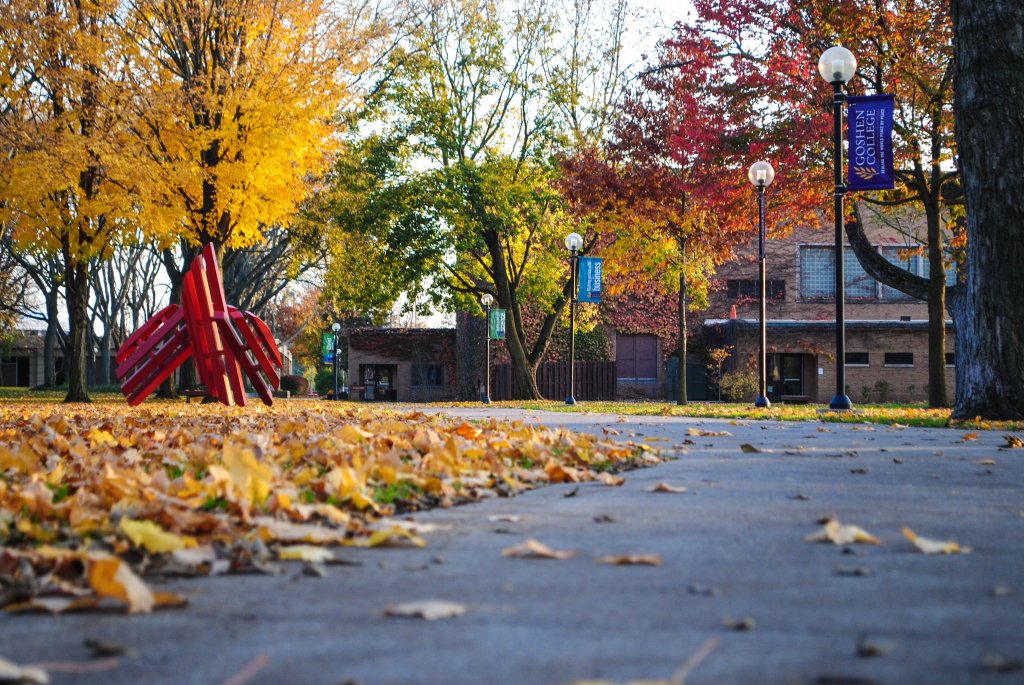
Why a Broken Shield, and Rifted Rock? Why is our core value Compassionate Peacemaking? Why not just peacemaking?
Because peacemaking cannot happen without a degree of openness to the world. Compassion means to feel with. That is why we begin this year and every year with an acknowledgment of the violent displacement of Potawatomi and Miami people from the land we now know as Goshen College’s campus. It is a small gesture, but it is a step toward correcting the stories and practices that erase Indigenous people’s history and culture and toward inviting and honoring the truth.
There is so much in the world today that is broken and violent. It can be overwhelming. My goodness, I know. I feel that.
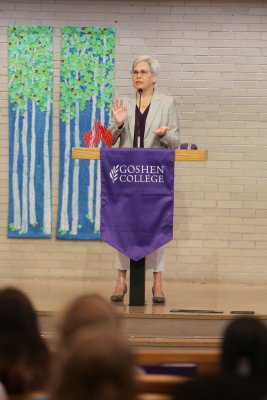
And so I want to leave you with this physical expression of what it means to be a rifted rock. Consider these two hand positions: this (hands open, palms up) and this (hands in front of body in a stop gesture). Both are important. Compassionate peacemaking requires openness. And compassionate peacemaking requires boundaries. Compassion means feeling with, but it does not mean merging with. Empathy is not agreement. We need boundaries that protect ourselves and protect each other. Compassionate peacemaking does not mean being open to everything, all the time.
Rocks are powerful metaphors for a reason. After all, we are not called to be Jello.
I leave you with this posture.
My hope for this year is that we can find the rifted rocks we need to provide us sanctuary in the turbulence of these times, and that we can BE rifted rocks for one another, building strong foundations of peace, protecting each others’ backs, opening ourselves to one another and holding our boundaries, in the ways of peace.

